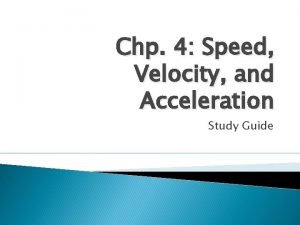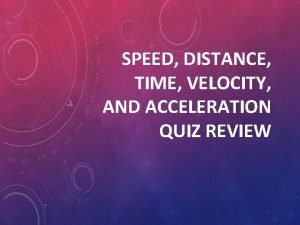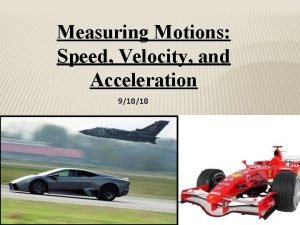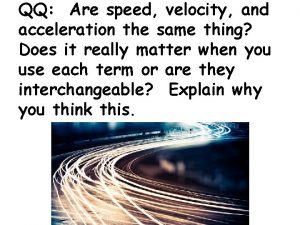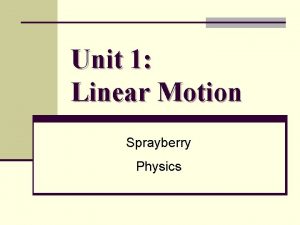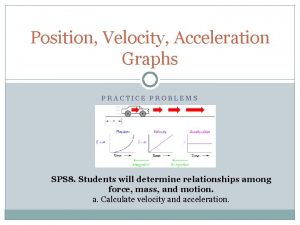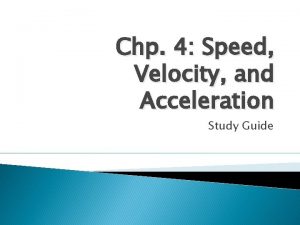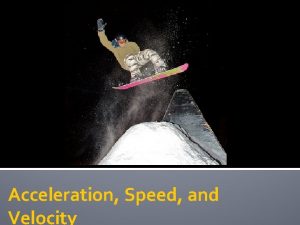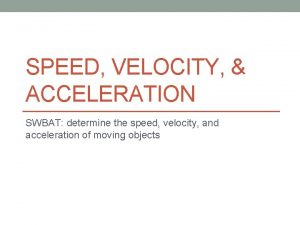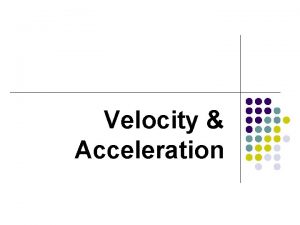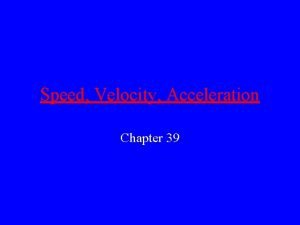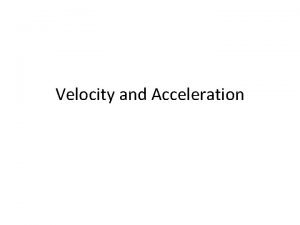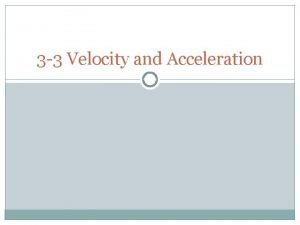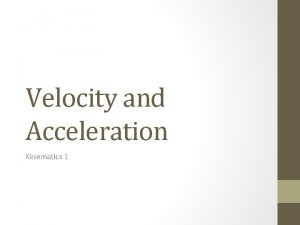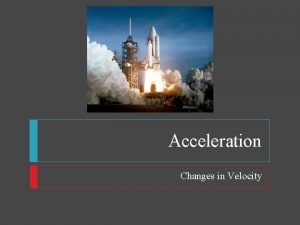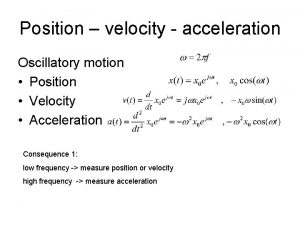Chp 4 Speed Velocity and Acceleration Study Guide















- Slides: 15

Chp. 4: Speed, Velocity, and Acceleration Study Guide

Average Speed � Total distance traveled divided the total time taken to travel that distance. Speed=Distance/Time � Ex: A soccer ball takes 60 seconds to roll 30 meters. Average speed=30 meters/60 sec=0. 5 m/s

Practice Problem � The workers placed 125 meters of asphalt in 2. 5 hours. What was their average speed? � Answer: 50 m/hr � Formula: S=D T � Equation: S = 125 2. 5 � S = 50 m/hr

Formula � If you need to find speed (distance/time) � If you need to find time (distance/speed) � If you need to find distance (speed x time) Formula Fact Triangle

Velocity � The speed and direction of a moving object. � Ex. 200 m/s West (speed and direction) � There are 3 things that can change velocity 1. Change in speed 2. Change in direction 3. Change in both

Changes in Velocity � Ex. A car is on a curving road, so velocity is changing. As long as you’re turning, the velocity is changing. � Ex. A car is moving and then stops at a stop light. Because the car’s speed changed, the velocity changed.

Acceleration �A change in velocity during a period of time. Acceleration=change in speed/time= m/s 2 � When you’re speeding up your velocity and your acceleration move in the same direction � When you’re slowing down, your velocity and your acceleration move in opposite directions.

Acceleration cont. � If time and speed change you have to find the differences of highest data point and lowest data point of the two. � Ex. Times (sec)=1, 2, 3, 4, 5 Difference=5 -1=4 sec Velocity (m/sec, N)=2, 2. 5, 3, 3. 5, 4 Difference=4 -2=2 m/s N Acceleration=2/4=0. 5 m/s 2

Practice Problem � During a bike race, a cyclist accelerates to the north from 8 meters per second to 10 meters per second in 5 seconds to finish the race. What is his acceleration? � Formula: final speed-initial speed Time 10 m/s – 8 m/s = 2 m/s = 0. 4 m/s 2 5 seconds 5 sec

Distance-Time Graphs �A graph comparing distance and time. � X-axis=time, Y-axis=distance

Example of Distance-Time Graph � When speed is constant, distance and time are increasing at the same rate.

Example of Distance-Time Graph � When the graph line is flat (horizontal), the object is not moving. Time is going by, but distance is not increasing.

Example of Distance-Time Graph � When the graph line is curved upward, the object’s speed is increasing because distance is increasing faster than time.

Example of Distance-Time Graph � When the graph line is curved downward towards a flat line, the object’s speed is decreasing because time is increasing faster than distance. Decreasing speed can also look like this

Example of Distance-Time Graph � The steeper the slope of the graph line, the faster the speed. faster slower
 Speed velocity and acceleration study guide answers
Speed velocity and acceleration study guide answers Speed and velocity quiz
Speed and velocity quiz Speed, velocity and acceleration problems
Speed, velocity and acceleration problems Apewlklar-u -site:youtube.com
Apewlklar-u -site:youtube.com Speed velocity acceleration
Speed velocity acceleration Are speed and acceleration the same thing
Are speed and acceleration the same thing What is acceleration
What is acceleration Final velocity initial velocity acceleration time
Final velocity initial velocity acceleration time Deceleration formula
Deceleration formula Angular quantities and linear quantities cannot be related.
Angular quantities and linear quantities cannot be related. Linear acceleration
Linear acceleration Centripetal acceleration tangential acceleration
Centripetal acceleration tangential acceleration Difference between velocity and acceleration example
Difference between velocity and acceleration example Velocity and acceleration difference
Velocity and acceleration difference Relative velocity si unit
Relative velocity si unit Position velocity acceleration
Position velocity acceleration
